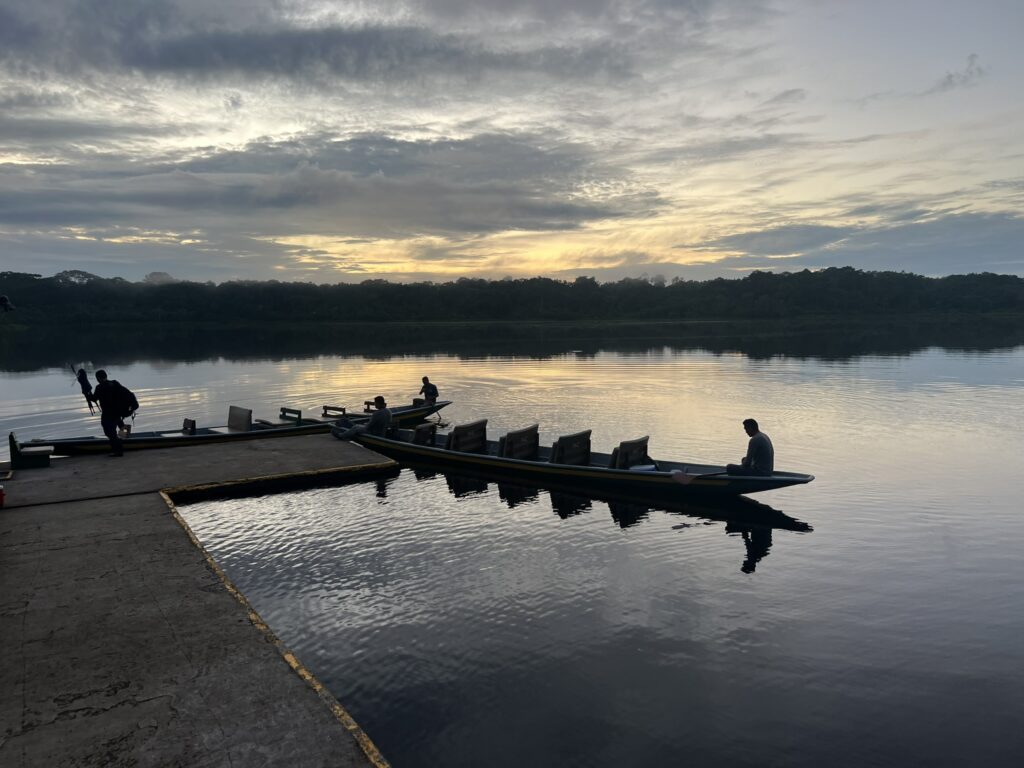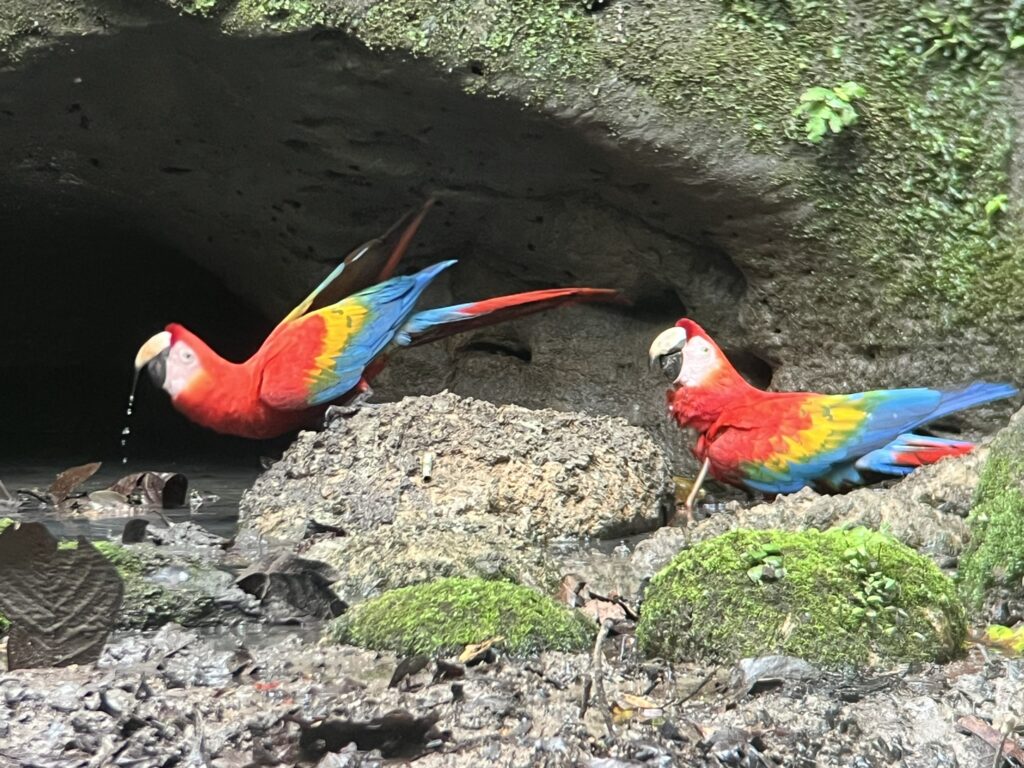Yasuni National Park in the Ecuadorian Amazon is the most biodiverse place on Earth. We stayed at the Napo Wildlife Center with the Kichwa Añangu community to explore this amazing area.
Best Thing I Ate This Week
Comida tipica (Typical Food) at Kurimuyu Centro de Interpretacion

The women of the Kichwa Añangu community started the Kurimuyu Centro de Interpretacion as a way to preserve their culture and share it with those that come to visit Yasuni National Park. Kurimuyu means “golden seed” in the native Kichwa language and symbolizes the invaluable wisdom the women share through their traditional dances, rituals, handicrafts, food, and drinks. During our stay at the Napo Wildlife Center we spent an morning there learning and participating in the Kichwa Añangu traditions.

Our visit started by learning more about the history of the center, and then we were welcomed with a traditional dance that we were encouraged to participate in. After the welcome, we moved to a historical and traditional home where we learned about the old hunting traditions of the community. We received a demonstration on how to use a blow dart gun, and I was asked to give it a try. With a little beginners luck and guidance I was able to hit the target on my first try much to the surprise of the group (myself included).


While the demonstration was ongoing, a few of the women from the community were finishing up cooking their typical food from the Amazon. We were then invited to make a plate from a delicious spread of yucas, vegetables, and chontacuro (larva referred to as jungle bacon). There was also a hot sauce that we were warned was very spicy but told would be a nice complement to the food. I loved the flavor of the hot sauce, which was indeed very spicy but went perfectly with the spread. One of the community members even offered me a traditional glass of chicha, which is a fermented yeast drink that increases in alcohol strength the longer it ferments. This was one of the most unique experiences and meals I ever have tried. After the meal we were able to buy handmade souvenirs which was a great way to conclude this memorable experience from wonderful hosts.

An Interesting Fact I Learned
Yasuni National Park is regarded as the most bio-diverse area

Yasuni National Park is located in the Ecuadorian Amazon, on the border with Peru. Its geographic positioning brings together unique ecosystems as it sits at the intersection of Andes, Equator, and Amazon regions. Given this intersection, there is a convergence of wildlife that has led scientists to proclaim this national park as the most bio-diverse on Earth. The Ecuadorian government has recognized this fact by making it the largest protected area of land on the country’s mainland.

A few facts that we learned while visiting helped to put into perspective the staggering diversity of this region. For example, there have been over 2000 species of trees/bushes identified with one study finding over 650 species in just a hectare of land. In that one hectare of land in Yasuni, there are more species of trees than all of the United States and Canada combined. The park is also a bird watchers paradise as nearly 600 species have been identified there. This quantity makes up about 1/3 of all the bird species in the entire Amazon rainforest. Additionally there are thought to be nearly 100 bat species, over 100 amphibian/reptile species, thousands of plant species, and hundreds of thousand of insect species per hectare.


During our visit we were up early each morning to take advantage of the cooler weather to see the animals while they were most active. We saw numerous species of macaws, toucans, monkeys, and other marvelous birds. Throughout our navigation on the small rivers we passed through the dense diverse forest and saw many surprises in the water such as anacondas, caimans, giant otters, and even a close encounter with an arapaima (the largest freshwater fish that grows up to 10 feet long). In the evening, we had the opportunity to explore the diverse forest in a different way to see the incredible insects and amphibians although I could have done without the encounters with the tarantulas and bullet ants. Within our short trip I truly felt like I had seen more variety of flora and fauna than anywhere else in my life which is remarkable knowing we only explored a small portion of this incredible national park.

My Travel Tip of the Week
Research Amazon lodge ownership before booking your stay
During our time in South America we visited many countries that offer the ability to explore the Amazon rainforest. For our introduction to the Amazon we always wanted to try to visit while in Ecuador and see Yasuni National Park because we had heard it was remarkably bio-diverse and well preserved. Additionally, a few people we met spoke very highly of the upscale eco-lodge accommodations in Yasuni that were known for having exemplary guides to show visitors the park safely.

The 3 most popular lodges that we considered for our trip were Napo Wildlife Center, Sacha Lodge, and La Selva Lodge. What we eventually realized was that Napo Wildlife Center was the only lodge actually located in the Yasuni National Park. Additionally, it appeared from their website that it was run by the local indigenous community. This led us to book with them for our visit and after our stay we couldn’t have been happier with the decision.

During our stay, we learned that the Napo Wildlife Center was a project initiated by the Kichwa Añangu community 25 years ago. Some of the members of the community had experience working in other nearby upscale lodges, but they saw that the profits were going back to the foreign owners. They dreamed of building a lodge on their own land, so all of the profits could go back into their community. With the help of an NGO, the community was able to secure funding to build a premier eco-lodge on a beautiful secluded lake on their community designated land.

In order to achieve success, the community decided to give up hunting of the animals and vowed to never allow oil companies to work on their land. Through hard work and dedication, the Napo Wildlife Center came to be the top recognized indigenous project in the entire Amazon. There is a large wall of awards displayed at the lodge which shows how successful they have been with this project. After a handful of years the community fully paid back the NGO investors and today have used the profits from the lodge to improve their community as well as build a second lodge within the community. They also have built two observation towers to see the forest from above and intend to build a third lodge in the future.

Most of the workers at the lodges and the business offices come from their community, which provides great compensation to enable them to take care of their families. I was truly impressed with the level of professionalism and kindness from the booking process through our departure. From the moment we arrived at the lodge, everyone was eager to share their culture and had so much pride in showing off the biodiversity that thrived on their land.
You can read more about picking the best ecolodge here.
The Best Way To Visit The Amazon Rainforest Of Ecuador
Looking to explore the Amazon Rainforest? Let’s talk about the most sustainable and appropriate way to do that, while seeing the most that the Amazon Rainforest has to offer.

My Additional Anecdote This Week
Sustained conservation efforts make a big difference

Many communities in the Amazon sell their land to oil companies, logging firms, or allow extensive bush hunting. These opportunities provide quick and lucrative amounts of money to flow to the community but many times have devastating long term consequences to their well being and ultimately the resources dry up when the environment is destroyed. The Kichwa Añangu community realized that if they gave up hunting and turned down the oil money, they could preserve their land and build a sustainable lifestyle centered around eco-tourism.

When they started the project in 1998 the Anangu Lake had been sufficiently hunted so much so that many of the members of the community used to go swimming in it. After making a decision to stop that activity and focus on conservation, nearly 25 years later it is far too dangerous to swim in the lake because the native species have returned. During our time on the lake we saw caimans, anacondas, and a massive arapaima from the safety of our canoes. The return of the native species was a great point of pride for the community and our naturalist (Guido) told us that the efforts were so successful that the animals now know to come to this area to be safe from human destruction in other non-protected areas. This safe environment for the animals allows for incredible close up nature watching for tourists and more importantly ensures the community can share the special species of the rainforest with their future generations.

You can read more about our experience at Napo Wildlife Center here:
Our Experience At Napo Wildlife Center: A Luxury Rainforest Experience
Our experience with the Napo Wildlife Center to explore Ecuadorian rainforest. Why did we choose this company and what did we get to see within the rainforest? Read to find out!




